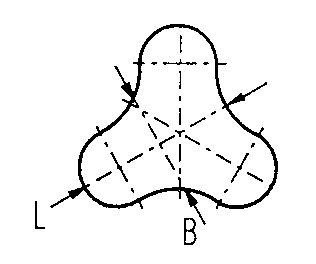Some of the information on this Web page has been provided by external sources. The Government of Canada is not responsible for the accuracy, reliability or currency of the information supplied by external sources. Users wishing to rely upon this information should consult directly with the source of the information. Content provided by external sources is not subject to official languages, privacy and accessibility requirements.
Any discrepancies in the text and image of the Claims and Abstract are due to differing posting times. Text of the Claims and Abstract are posted:
| (12) Patent: | (11) CA 2116779 |
|---|---|
| (54) English Title: | SHAPED-SECTION FINE-FIBRE FILAMENT YARN AND METHOD OF PRODUCING IT |
| (54) French Title: | FIL CONTINU A FIBRE FINE PROFILEE, METHODE DE FABRICATION |
| Status: | Expired and beyond the Period of Reversal |
| (51) International Patent Classification (IPC): |
|
|---|---|
| (72) Inventors : |
|
| (73) Owners : |
|
| (71) Applicants : |
|
| (74) Agent: | GOWLING WLG (CANADA) LLPGOWLING WLG (CANADA) LLP |
| (74) Associate agent: | |
| (45) Issued: | 2003-06-17 |
| (86) PCT Filing Date: | 1993-07-01 |
| (87) Open to Public Inspection: | 1994-01-20 |
| Examination requested: | 2000-06-30 |
| Availability of licence: | N/A |
| Dedicated to the Public: | N/A |
| (25) Language of filing: | English |
| Patent Cooperation Treaty (PCT): | Yes |
|---|---|
| (86) PCT Filing Number: | PCT/CH1993/000168 |
| (87) International Publication Number: | WO 1994001603 |
| (85) National Entry: | 1994-03-01 |
| (30) Application Priority Data: | ||||||
|---|---|---|---|---|---|---|
|
A profiled fine-fiber filament yarn of polyamide POY
with a yarn viscosity RV of 40 to 55 and a strength of 30 to
45 cN/tex, with a fiber titer of less than 1.5 dtex, a color
uniformity with a coefficient of variation of less than 2,
and a width/length ratio B/L of the fiber cross section of
0.5 to 0.7 is provided as a feed yarn for texturing. In the
production process, extrusion is carried out at a rate of 8
to 14 m/min through a nozzle with a capillary surface area
of 0.05 to 0.1 mm2 per capillary and the solidified
filaments are stretched to form a POY.
Note: Claims are shown in the official language in which they were submitted.
Note: Descriptions are shown in the official language in which they were submitted.

2024-08-01:As part of the Next Generation Patents (NGP) transition, the Canadian Patents Database (CPD) now contains a more detailed Event History, which replicates the Event Log of our new back-office solution.
Please note that "Inactive:" events refers to events no longer in use in our new back-office solution.
For a clearer understanding of the status of the application/patent presented on this page, the site Disclaimer , as well as the definitions for Patent , Event History , Maintenance Fee and Payment History should be consulted.
| Description | Date |
|---|---|
| Time Limit for Reversal Expired | 2008-07-02 |
| Letter Sent | 2007-07-03 |
| Grant by Issuance | 2003-06-17 |
| Inactive: Cover page published | 2003-06-16 |
| Inactive: Final fee received | 2003-03-31 |
| Pre-grant | 2003-03-31 |
| Notice of Allowance is Issued | 2003-03-06 |
| Letter Sent | 2003-03-06 |
| Notice of Allowance is Issued | 2003-03-06 |
| Inactive: Approved for allowance (AFA) | 2003-02-10 |
| Amendment Received - Voluntary Amendment | 2002-11-25 |
| Inactive: S.30(2) Rules - Examiner requisition | 2002-05-24 |
| Amendment Received - Voluntary Amendment | 2000-10-26 |
| Inactive: Application prosecuted on TS as of Log entry date | 2000-08-07 |
| Letter Sent | 2000-08-07 |
| Inactive: Status info is complete as of Log entry date | 2000-08-07 |
| All Requirements for Examination Determined Compliant | 2000-06-30 |
| Request for Examination Requirements Determined Compliant | 2000-06-30 |
| Application Published (Open to Public Inspection) | 1994-01-20 |
There is no abandonment history.
The last payment was received on
Note : If the full payment has not been received on or before the date indicated, a further fee may be required which may be one of the following
Please refer to the CIPO Patent Fees web page to see all current fee amounts.
| Fee Type | Anniversary Year | Due Date | Paid Date |
|---|---|---|---|
| MF (application, 4th anniv.) - standard | 04 | 1997-07-02 | 1997-06-16 |
| MF (application, 5th anniv.) - standard | 05 | 1998-07-02 | 1998-06-10 |
| MF (application, 6th anniv.) - standard | 06 | 1999-07-01 | 1999-06-09 |
| MF (application, 7th anniv.) - standard | 07 | 2000-07-03 | 2000-06-14 |
| Request for examination - standard | 2000-06-30 | ||
| MF (application, 8th anniv.) - standard | 08 | 2001-07-02 | 2001-06-15 |
| MF (application, 9th anniv.) - standard | 09 | 2002-07-02 | 2002-06-19 |
| Final fee - standard | 2003-03-31 | ||
| MF (patent, 10th anniv.) - standard | 2003-07-02 | 2003-06-16 | |
| MF (patent, 11th anniv.) - standard | 2004-07-01 | 2004-06-16 | |
| MF (patent, 12th anniv.) - standard | 2005-07-01 | 2005-06-07 | |
| MF (patent, 13th anniv.) - standard | 2006-07-03 | 2006-06-07 | |
| MF (application, 2nd anniv.) - standard | 02 | 1995-07-03 |
Note: Records showing the ownership history in alphabetical order.
| Current Owners on Record |
|---|
| RHONE-POULENC VISCOSUISSE SA |
| Past Owners on Record |
|---|
| HANS-GEORG KRAMER |